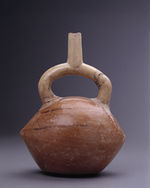Carica papaya
| Papaya | |
|---|---|
 |
|
| Papaya tree and fruit, from Koehler's Medicinal-Plants (1887) | |
| Scientific classification | |
| Kingdom: | Plantae |
| (unranked): | Angiosperms |
| (unranked): | Eudicots |
| (unranked): | Rosids |
| Order: | Brassicales |
| Family: | Caricaceae |
| Genus: | Carica |
| Species: | C. papaya |
| Binomial name | |
| Carica papaya L. |
|
The papaya (from Carib via Spanish), papaw or pawpaw is the fruit of the plant Carica papaya, in the genus Carica. It is native to the tropics of the Americas, and was first cultivated in Mexico several centuries before the emergence of the Mesoamerican classic cultures.
It is a large tree-like plant, with a single stem growing from 5 to 10 metres (16 to 33 ft) tall, with spirally arranged leaves confined to the top of the trunk. The lower trunk is conspicuously scarred where leaves and fruit were borne. The leaves are large, 50–70 centimetres (20–28 in) diameter, deeply palmately lobed with 7 lobes. The tree is usually unbranched if unlopped. The flowers are similar in shape to the flowers of the Plumeria but are much smaller and wax-like. They appear on the axils of the leaves, maturing into the large 15–45 centimetres (5.9–18 in) long, 10–30 centimetres (3.9–12 in) diameter fruit. The fruit is ripe when it feels soft (like a ripe avocado or a bit softer) and its skin has attained an amber to orange hue.
It is the first fruit tree to have its genome deciphered.[1]
Contents |
Common names
In North America the term pawpaw may also refer to the fruit of trees in the unrelated North American genus Asimina. However, pawpaw and papaw are common synonyms of papaya both in North America and elsewhere.[2][3] It is sometimes called mugua and is therefore confused with Chaenomeles speciosa or Pseudocydonia sinensis which are called mugua in Traditional Chinese Medicine.[4]
Cultivation
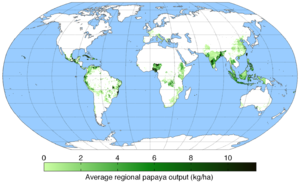
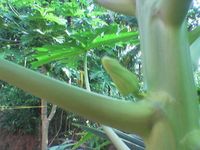
Originally from southern Mexico, particularly Chiapas and Veracruz, Central America and northern South America, the papaya is now cultivated in most tropical countries, such as Brazil, Bangladesh, Pakistan, India, Indonesia, South Africa, Sri Lanka, Vietnam, Philippines and Jamaica. In cultivation, it grows rapidly, fruiting within 3 years. It is, however, highly frost sensitive.
The papaya fruit is susceptible to the papaya fruit fly. This wasp-like fly lays its eggs in young fruit.
In the 1990s, the papaya ringspot virus threatened to wipe out Hawaii’s papaya industry completely. Two varieties of papaya, SunUp and Rainbow, that had been genetically modified to be resistant to the virus, were introduced into Hawaii.[5] By 2010 80% of Hawaiian papaya was genetically modified. Today there is still no conventional or organic method of controlling the ringspot virus.[6] In 2004, non-genetically modified and organic papayas throughout Hawaii had experienced hybridization with the genetically modified varieties.[7]
Uses
Papaya can be used as a food, a cooking aid, and in medicine. The stem and bark are also used in rope production.
Gastronomy
The ripe fruit is usually eaten raw, without skin or seeds. The unripe green fruit of papaya can be eaten cooked, usually in curries, salads and stews. It has a relatively high amount of pectin, which can be used to make jellies.
Green papaya is used in Thai cuisine, both raw and cooked.[8]
The black seeds are edible and have a sharp, spicy taste. They are sometimes ground up and used as a substitute for black pepper. In some parts of Asia the young leaves of papaya are steamed and eaten like spinach. In parts of the world papaya leaves are made into tea as a preventative for malaria, though there is no real scientific evidence for the effectiveness of this treatment.[9]
| Nutritional value per 100 g (3.5 oz) | |
|---|---|
| Energy | 163 kJ (39 kcal) |
| Carbohydrates | 9.81 g |
| Sugars | 5.90 g |
| Dietary fibre | 1.8 g |
| Fat | 0.14 g |
| Protein | 0.61 g |
| Vitamin A equiv. | 55 μg (6%) |
| - beta-carotene | 276 μg (3%) |
| Thiamine (Vit. B1) | 0.04 mg (3%) |
| Riboflavin (Vit. B2) | 0.05 mg (3%) |
| Niacin (Vit. B3) | 0.338 mg (2%) |
| Vitamin B6 | 0.1 mg (8%) |
| Vitamin C | 61.8 mg (103%) |
| Calcium | 24 mg (2%) |
| Iron | 0.10 mg (1%) |
| Magnesium | 10 mg (3%) |
| Phosphorus | 5 mg (1%) |
| Potassium | 257 mg (5%) |
| Sodium | 3 mg (0%) |
| Percentages are relative to US recommendations for adults. |
|
Cooking
Green papaya fruit and the tree's latex are both rich in an enzyme called papain, a protease which is useful in tenderizing meat and other proteins. Its ability to break down tough meat fibers was used for thousands of years by indigenous Americans. It is included as a component in powdered meat tenderizers.
Medicine
Papaya is marketed in tablet form to remedy digestive problems.
Papain is also applied topically (in countries where it grows) for the treatment of cuts, rashes, stings and burns. Papain ointment is commonly made from fermented papaya flesh, and is applied as a gel-like paste. Harrison Ford was treated for a ruptured disc incurred during filming of Indiana Jones and the Temple of Doom by papain injections.[10]
Women in India, Bangladesh, Pakistan, Sri Lanka, and other countries have long used green papaya as a folk remedy for contraception and abortion. Enslaved women in the West Indies were noted for consuming papaya to prevent pregnancies and thus preventing their children from being born into slavery. Medical research in animals has confirmed the contraceptive and abortifacient capability of papaya, and also found that papaya seeds have contraceptive effects in adult male langur monkeys, possibly in adult male humans as well.[11] Unripe papaya is especially effective in large amounts or high doses. Ripe papaya is not teratogenic and will not cause miscarriage in small amounts. Phytochemicals in papaya may suppress the effects of progesterone.[12]
Allergies and side effects
Papaya is frequently used as a hair conditioner, but should be used in small amounts. Papaya releases a latex fluid when not quite ripe, which can cause irritation and provoke allergic reaction in some people. The papaya fruit, seeds, latex, and leaves also contains carpaine, an anthelmintic alkaloid (a drug that removes parasitic worms from the body), which can be dangerous in high doses.
It is speculated that unripe papayas may cause miscarriage due to latex content that may cause uterine contractions which may lead to a miscarriage. Papaya seed extracts in large doses have a contraceptive effect on rats and monkeys, but in small doses have no effect on the unborn animals.
Excessive consumption of papaya can cause carotenemia, the yellowing of soles and palms, which is otherwise harmless. However, a very large dose would need to be consumed; papaya contains about 6% of the level of beta carotene found in carrots (the most common cause of carotenemia) per 100g.[13]
Medicinal potential
- The juice has an antiproliferative effect on in vitro liver cancer cells, probably due to its component of lycopene [15] or immune system stimulation.[16]
- Papaya seed could be used as an antibacterial agent for Escherichia coli, Staphylococcus aureus or Salmonella typhi, although further research is needed before advocating large-scale therapy.[17]
- Papaya seed extract may be nephroprotective (protect the kidneys) in toxicity-induced kidney failure[18]
Diseases
Names in other languages
Translations are available at Wiktionary:papaya.
Photo gallery
 Papaya tree |
Papaya tree, India |
Papaya tree, India |
Papaya tree, India |
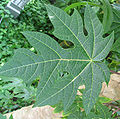 Papaya leaf |
 Female flowers |
 Papaya |
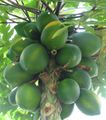 Papaya trunk with immature fruit |
 tree and flowers, from Koehler's Medicinal-Plants (1887) |
 Hawaiian papaya (with lilies and ginger) |
Tanzanian papaya tree |
 An Indian papaya tree |
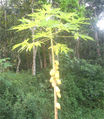 A variety of yellow papaya in Kerala, India, the unripe fruit has even yellow skin, looks like ripe papaya. |
 Carica papaya tree with fruit in Cáceres, Brazil |
Notes and references
- ↑ University of Granada
- ↑ Merriam-Webster Online: pawpaw
- ↑ Delbridge, A., and J. R. L. Bernard. 1988 The Macquarie Concise Dictionary. The Macquarie Library: Sydney.
- ↑ Subhuti Dharmananda 2005. "Chaenomeles: A relaxing and strengthening fruit" in Institute for Traditional Medicine database [1]
- ↑ http://www.hawaiipapaya.com/rainbow.htm hawaiipapaya.com
- ↑ Ronald, Pamela and McWilliams, James Genetically Engineered Distortions The New York Times, May 14, 2010. Retrieved August 10, 2010.
- ↑ http://www.grain.org/research/contamination.cfm?id=165 grain.org
- ↑ Green Papaya Salad Recipe - ThaiTable.com
- ↑ [2]
- ↑ Entry on Harrison Ford's back treatment.
- ↑ Lohiya, N. K.; B. Manivannan, P. K. Mishra, N. Pathak, S. Sriram, S. S. Bhande, and S. Panneerdoss (March 2002). "Chloroform extract of Carica papaya seeds induces long-term reversible azoospermia in langur monkey" (– Scholar search). Asian Journal of Andrology 4: 17–26. http://asiaandro.com/1008-682X/4/17.htm. Retrieved 2006-11-18.
- ↑ Oderinde, O. "Abortifacient properties of Carica papaya (Linn) seeds in female Sprague-Dawley rats". Niger Postgrad Medical Journal. PMID 12163882.
- ↑ "Search the USDA National Nutrient Database for Standard Reference". Nal.usda.gov. http://www.nal.usda.gov/fnic/foodcomp/search/. Retrieved 2010-08-18.
- ↑ Berrin, Katherine & Larco Museum. The Spirit of Ancient Peru:Treasures from the Museo Arqueológico Rafael Larco Herrera. New York: Thames and Hudson, 1997.
- ↑ Rahmat, Asmah et al.. "Antiproliferative activity of pure lycopene compared to both extracted lycopene and juices from watermelon (Citrullus vulgaris) and papaya (Carica papaya) on human breast and liver cancer cell lines". http://www.scialert.net/pdfs/jms/2002/55-58.pdf. Retrieved 9 May 2009.
- ↑ "Papaya extract thwarts growth of cancer cells in lab tests". http://www.sciencedaily.com/releases/2010/03/100309182449.htm?utm_source=feedburner&utm_medium=feed&utm_campaign=Feed%3A+sciencedaily+%28ScienceDaily%3A+Latest+Science+News%29. Retrieved 3 March 2010.
- ↑ "The invitro assessment of antibacterial effect of papaya seed extract against bacterial pathogens isolated from urine, wound and stool.". http://www.unboundmedicine.com/medline/ebm/record/18711992/full_citation/The_invitro_assessment_of_antibacterial_effect_of_papaya_seed_extract_against_bacterial_pathogens_isolated_from_urine_wound_and_stool_. Retrieved 14 October 2009.
- ↑ "Nephroprotective activities of the aqueous seed extract of Carica papaya Linn. in carbon tetrachloride induced renal injured Wistar rats: a dose- and time-dependent study". http://www.google.ca/url?sa=t&source=web&ct=res&cd=10&ved=0CDYQFjAJ&url=http%3A%2F%2Fwww.biolmedonline.com%2FArticles%2Fvol1_1_11-19.pdf&ei=cKEFS6XvOMPJlAfxgM2dDA&usg=AFQjCNHjN43grF4tKJxnPv4UK2pe5H3-pQ&sig2=pBPEiQ50nx8ptdJp3J3apw. Retrieved 19 November 2009.
See also
- Chaenomeles speciosa, Flowering quince, which like Carica papaya is called mugua
- Pawpaw
- Pseudocydonia, also called mugua
External links
- Fruits of Warm Climates: Papaya and Related Species
- Nutrition Facts and Health Benefits of Papayas
- Carica papaya
- California Rare Fruit Growers: Papaya Fruit Facts.
- Papaya Fruit Nutrition
- Treating Livestock with Medicinal Plants: Beneficial or Toxic? Carica papaya
- Papaya Fruit - Internet Documentation
- Papaya recipe
